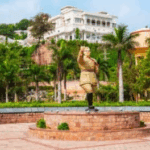
Exploring Sigiriya Rock: Sri Lanka’s Majestic Fortress

Nestled in the heart of Sri Lanka, Sigiriya Rock stands as a testament to the island’s rich history and architectural ingenuity. Known as the “Lion Rock,” this ancient fortress and its surrounding gardens are a UNESCO World Heritage site and one of Sri Lanka’s most iconic landmarks. From its fascinating history and speculations about its origins to the breathtaking views from the summit, Sigiriya offers a captivating journey through time and nature.
Historical Background
Sigiriya, also known as Sinhagiri, meaning “Lion Rock” in Sinhala, dates back to the 5th century AD. It was during this time that King Kashyapa (477-495 AD) chose Sigiriya as the site for his new capital. The rock fortress was constructed on top of a massive 200-meter high rock, strategically positioned to provide a commanding view of the surrounding landscape and to serve as a formidable defensive structure.
King Kashyapa, who seized the throne from his father, King Dhatusena, is believed to have built Sigiriya both as a royal palace and a fortress to protect himself from his half-brother Moggallana, who sought revenge for their father’s death. The site was transformed into an elaborate complex, complete with a royal palace, terraced gardens, water gardens, and extensive frescoes.
Architectural Marvel
One of the most remarkable aspects of Sigiriya is its advanced engineering and architectural design. The entrance to the fortress is marked by a giant pair of lion’s paws, which once formed the base of a huge lion structure that visitors had to pass through to reach the palace. This feature gave Sigiriya its name, “Lion Rock.”
The fortress complex includes:
- Terraced Gardens: Carved into the rock’s slopes, these gardens are a testament to ancient landscaping skills.
- Water Gardens: Featuring sophisticated irrigation systems, fountains, and pools that are still operational today.
- Boulder Gardens: Pathways and rock formations that create a natural labyrinth.
- Frescoes: The famous Sigiriya frescoes, depicting celestial maidens, adorn the western face of the rock and offer a glimpse into ancient artistry.
Speculations and Mysteries
The history of Sigiriya is shrouded in mystery and speculation. Some historians believe that it was primarily a royal residence, while others suggest it was a Buddhist monastery before and after King Kashyapa’s reign. The site’s layout, with its symmetrical gardens and advanced water management system, indicates a sophisticated understanding of urban planning and hydraulic engineering.
Personal Experience
I had the opportunity to visit this historic place twice, in July of 2023 and 2024. Each visit was an incredible experience, offering new perspectives and deeper appreciation for this ancient marvel. Climbing Sigiriya Rock is an adventure in itself, with narrow staircases and steep inclines that lead to the summit.
The View from the Top
Reaching the top of Sigiriya Rock is a rewarding experience. The summit, known for its strong winds, offers a panoramic view of the lush Sri Lankan landscape, stretching as far as the eye can see. The flat-topped summit once housed the royal palace and today provides visitors with breathtaking vistas and a sense of the grandeur that once existed there.
The Lion’s Paws and Windy Summit
One of the most striking features of Sigiriya is the Lion’s Paws structure. The giant lion’s paws, which are all that remain of a colossal lion statue, guard the final ascent to the summit. Climbing between these paws is a humbling experience, evoking the power and majesty of the ancient fortress.
Proximity and Accessibility
Sigiriya is conveniently located in central Sri Lanka, making it easily accessible from major cities. It is approximately 160 kilometers from Colombo, the capital, and about 75 kilometers from Kandy. The fortress is also close to Dambulla, famous for its cave temples.
Statistics and Quick Facts
- Location: Central Sri Lanka, near the town of Dambulla
- Height: Approximately 200 meters
- UNESCO World Heritage Site: Designated in 1982
- Distance from Colombo: Approximately 160 kilometers
- Distance from Kandy: Approximately 75 kilometers
- Popular Features: Lion’s Paws, frescoes, water gardens, terraced gardens
- Visitor Numbers: Over 1 million annually
Conclusion
Sigiriya Rock is more than just a historical site; it is a symbol of Sri Lanka’s rich cultural heritage and architectural brilliance. From the meticulous design of its gardens to the majestic views from its windy summit, Sigiriya offers a unique glimpse into the island’s past. Whether you are a history enthusiast, an architecture aficionado, or simply a traveler seeking breathtaking views, Sigiriya is a must-visit destination. My visits in July 2023 and 2024 have only deepened my appreciation for this awe-inspiring fortress, and I highly recommend experiencing it for yourself.
Hello, I am Aman (: Full Time Traveler :) At the age of 41, in April 2023, fueled by my love for travel and the determination not to remain fixed like a tree, I embarked on a bold journey. Having dedicated 17 years to a corporate job, I chose to transition from a full-time employee to a full-time traveler, driven by the desire to break free from the routine and constraints of a conventional life. Along the way, I not only explored the wonders of travel but also uncovered the transformative power of financial freedom. I realized how it could liberate me to lead a life teeming with adventure, purpose, and fulfillment. Through my blogs, I am passionately sharing my story, aiming to inspire and provide valuable guidance to those, like me, who aspire to weave travel into a life overflowing with limitless possibilities.






















Post Comment
You must be logged in to post a comment.